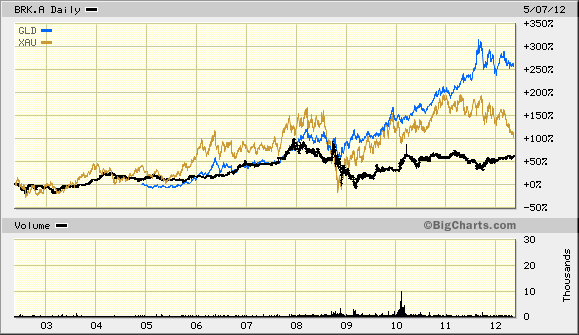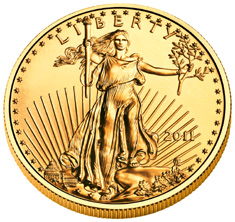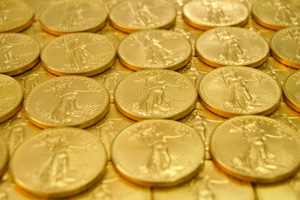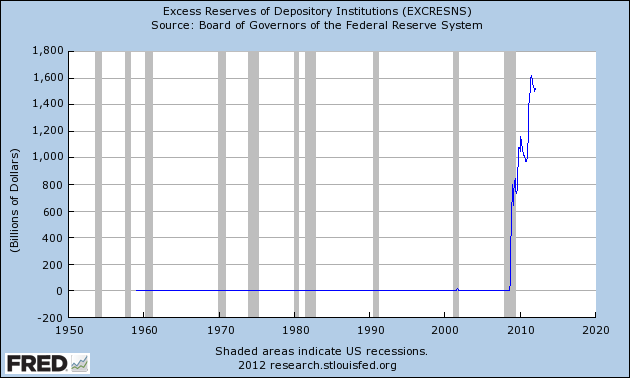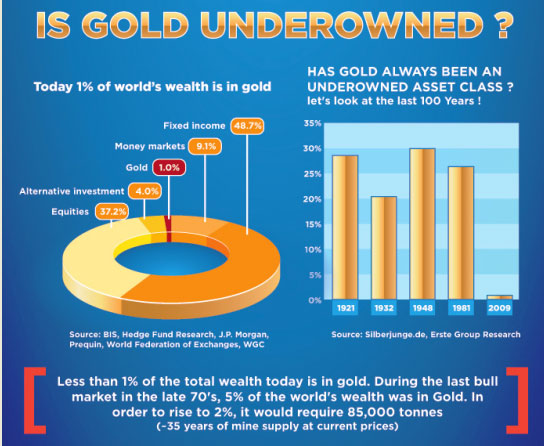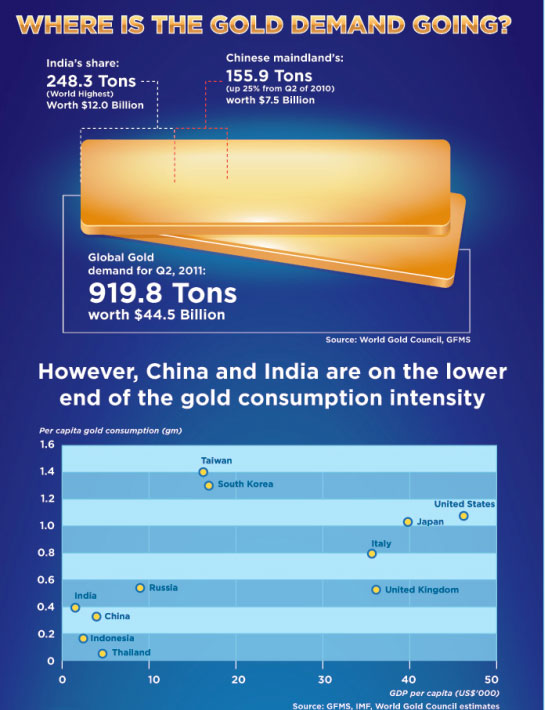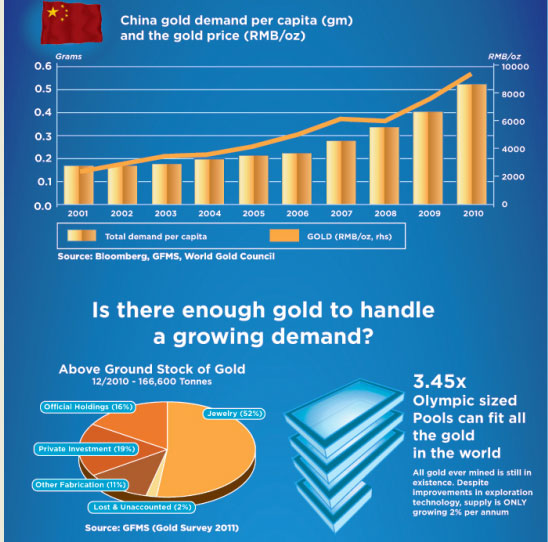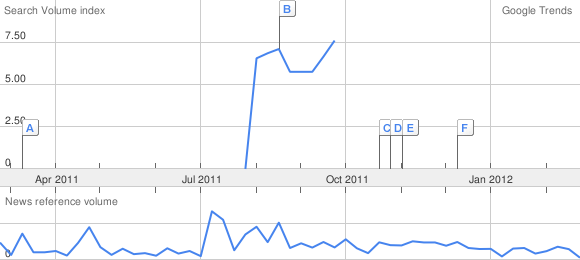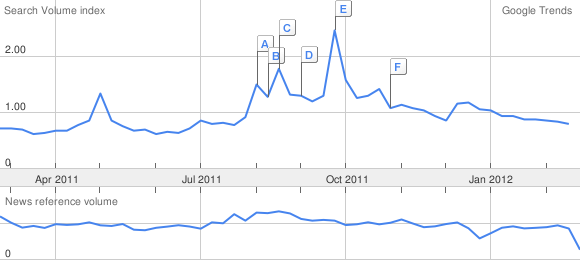 According to Warren Buffett, the decade long rally in gold has been based solely on fear and the greater fool theory. Buffett, believed by many to be one of the greatest investors of all time, has gone out of his way lately to ridicule gold investors.
According to Warren Buffett, the decade long rally in gold has been based solely on fear and the greater fool theory. Buffett, believed by many to be one of the greatest investors of all time, has gone out of his way lately to ridicule gold investors.
In his recent 2011 Letter to Shareholders of Berkshire Hathaway, Buffett notes that the purchasing power of the dollar “has fallen a staggering 86% in value since 1965”. According to Buffett, the three major investment categories available to investors are productive assets (such as stocks), currency based investments (such as bonds and bank deposits) and assets that will “never produce anything” (such as gold).
Buffett’s clear preference is to own productive assets. Currency based investments are “the most dangerous of assets” according to Buffett and gold (the major asset in the category of investments that “will never produce anything”) is described as follows in Buffett’s Letter to Shareholders.
This type of investment requires an expanding pool of buyers, who, in turn, are enticed because they believe the buying pool will expand still further. Owners are not inspired by what the asset itself can produce – it will remain lifeless forever – but rather by the belief that others will desire it even more avidly in the future.
The major asset in this category is gold, currently a huge favorite of investors who fear almost all other assets, especially paper money (of whose value, as noted, they are right to be fearful). Gold, however, has two significant shortcomings, being neither of much use nor procreative. True, gold has some industrial and decorative utility, but the demand for these purposes is both limited and incapable of soaking up new production. Meanwhile, if you own one ounce of gold for an eternity, you will still own one ounce at its end.
What motivates most gold purchasers is their belief that the ranks of the fearful will grow. During the past decade that belief has proved correct. Beyond that, the rising price has on its own generated additional buying enthusiasm, attracting purchasers who see the rise as validating an investment thesis. As “bandwagon” investors join any party, they create their own truth – for a while.
Charlie Munger, Berkshire Hathaway’s Vice-Chairman, in a recent CNBC interview, expounded on Buffett’s gold comments by stating that “Civilized people don’t buy gold. They invest in productive businesses.” By essentially calling gold investors “barbarians”, Munger turned things up a notch which elicited very compelling counterpoints from around the blogosphere.
The Munger Games – New York Sun
The fact is that people who bought gold a decade ago were far better positioned than those who put their money in Mr. Munger’s company, Berkshire Hathaway. For the value of a share of Berkshire Hathaway has collapsed over the past decade to barely more than 74 ounces of gold from the 238 ounces it was worth a decade ago.
Hmmm. Was it Ayn Rand on which Mr. Greenspan overdosed? In 1966, the future Fed chairman wrote for her newsletter an essay called “Gold and Economic Freedom.” It begins with the sentence “An almost hysterical antagonism toward the gold standard is one issue which unites statists of all persuasions. They seem to sense — perhaps more clearly and subtly than many consistent defenders of laissez-faire — that gold and economic freedom are inseparable. . .”The essay ends with the assertion that “[i]n the absence of the gold standard, there is no way to protect savings from confiscation through inflation” and that “[t]he financial policy of the welfare state requires that there be no way for the owners of wealth to protect themselves.”
And maybe the reason that Berkshire Hathaway shares have collapsed in value is that neither he nor Mr. Munger were paying attention to the civilizing effect of gold and economic freedom.
Financial Lexicon – “Civilized People Don’t Buy Gold”
For reasons about which a doctoral thesis could likely be written, humans have a long history of completely mismanaging fiat currencies. Throughout the countless historical examples of the leaders of nations destroying the value of that nation’s currency, gold, as a store of value, has stood the test of time.
Being aware of the historical inability of those who run nations to manage a fiat currency over an extended period of time without eventually destroying the purchasing power of the people is something that certain investors might not appreciate, understand, or care about. Warren Buffett admits that he won’t invest in things he doesn’t understand. And based on his and his colleague Mr. Munger’s comments on gold (not just the ones quoted in this article), it is quite clear they do not understand gold. Hence, they do not invest in it.
Warren Buffett clearly missed the first ten years of the gold bull market and his disdain for gold prevented him from achieving his primary investment goal of preserving purchasing power for his shareholders. Over the past decade, Berkshire Hathaway (BRK.A) has underperformed both gold bullion and gold stocks.
After over 10 years of being wrong, Buffett faces a major dilemma. Can he afford to continue rejecting the one asset class able to escape the government’s pernicious efforts to destroy the purchasing power of the dollar?
